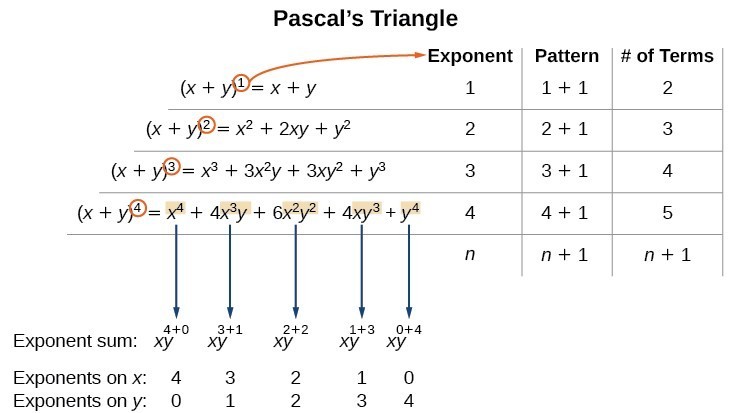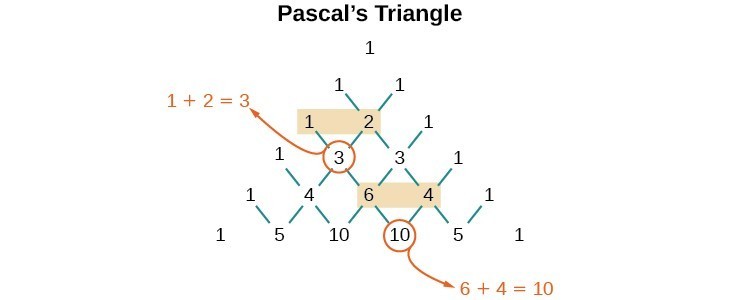Use the Binomial Theorem
Learning Objectives
- Identify binomial coefficients given the formula for a combination
- Expand a binomial using the binomial theorem
- Use the binomial to find a single term in a binomial
[latex]\left(\begin{array}{c}n\\ r\end{array}\right)=C\left(n,r\right)=\frac{n!}{r!\left(n-r\right)!}[/latex]
The combination [latex]\left(\begin{array}{c}n\\ r\end{array}\right)[/latex] is called a binomial coefficient. An example of a binomial coefficient is [latex]\left(\begin{array}{c}5\\ 2\end{array}\right)=C\left(5,2\right)=10[/latex].A General Note: Binomial Coefficients
If [latex]n[/latex] and [latex]r[/latex] are integers greater than or equal to 0 with [latex]n\ge r[/latex], then the binomial coefficient is[latex]\left(\begin{array}{c}n\\ r\end{array}\right)=C\left(n,r\right)=\frac{n!}{r!\left(n-r\right)!}
[/latex]Q & A
Is a binomial coefficient always a whole number?
Yes. Just as the number of combinations must always be a whole number, a binomial coefficient will always be a whole number.Example: Finding Binomial Coefficients
Find each binomial coefficient.- [latex]\left(\begin{array}{c}5\\ 3\end{array}\right)[/latex]
- [latex]\left(\begin{array}{c}9\\ 2\end{array}\right)[/latex]
- [latex]\left(\begin{array}{c}9\\ 7\end{array}\right)[/latex]
Answer: Use the formula to calculate each binomial coefficient. You can also use the [latex]{n}_{}{C}_{r}[/latex] function on your calculator.
[latex]\left(\begin{array}{c}n\\ r\end{array}\right)=C\left(n,r\right)=\frac{n!}{r!\left(n-r\right)!}[/latex]
- [latex]\left(\begin{array}{c}5\\ 3\end{array}\right)=\frac{5!}{3!\left(5 - 3\right)!}=\frac{5\cdot 4\cdot 3!}{3!2!}=10[/latex]
- [latex]\left(\begin{array}{c}9\\ 2\end{array}\right)=\frac{9!}{2!\left(9 - 2\right)!}=\frac{9\cdot 8\cdot 7!}{2!7!}=36[/latex]
- [latex]\left(\begin{array}{c}9\\ 7\end{array}\right)=\frac{9!}{7!\left(9 - 7\right)!}=\frac{9\cdot 8\cdot 7!}{7!2!}=36[/latex]
Analysis of the Solution
Notice that we obtained the same result for parts (b) and (c). If you look closely at the solution for these two parts, you will see that you end up with the same two factorials in the denominator, but the order is reversed, just as with combinations.[latex]\left(\begin{array}{c}n\\ r\end{array}\right)=\left(\begin{array}{c}n\\ n-r\end{array}\right)[/latex]
Try It
Find each binomial coefficient.- [latex]\left(\begin{array}{c}7\\ 3\end{array}\right)[/latex]
- [latex]\left(\begin{array}{c}11\\ 4\end{array}\right)[/latex]
Answer:
- 35
- 330
[latex]\begin{array}{l}{\left(x+y\right)}^{2}={x}^{2}+2xy+{y}^{2}\hfill \\ {\left(x+y\right)}^{3}={x}^{3}+3{x}^{2}y+3x{y}^{2}+{y}^{3}\hfill \\ {\left(x+y\right)}^{4}={x}^{4}+4{x}^{3}y+6{x}^{2}{y}^{2}+4x{y}^{3}+{y}^{4}\hfill \end{array}[/latex]
First, let’s examine the exponents. With each successive term, the exponent for [latex]x[/latex] decreases and the exponent for [latex]y[/latex] increases. The sum of the two exponents is [latex]n[/latex] for each term. Next, let’s examine the coefficients. Notice that the coefficients increase and then decrease in a symmetrical pattern. The coefficients follow a pattern:[latex]\left(\begin{array}{c}n\\ 0\end{array}\right),\left(\begin{array}{c}n\\ 1\end{array}\right),\left(\begin{array}{c}n\\ 2\end{array}\right),...,\left(\begin{array}{c}n\\ n\end{array}\right)[/latex].
These patterns lead us to the Binomial Theorem, which can be used to expand any binomial.[latex]\begin{array}{ll}{\left(x+y\right)}^{n}\hfill & =\sum _{k=0}^{n}\left(\begin{array}{c}n\\ k\end{array}\right){x}^{n-k}{y}^{k}\hfill \\ \hfill & ={x}^{n}+\left(\begin{array}{c}n\\ 1\end{array}\right){x}^{n - 1}y+\left(\begin{array}{c}n\\ 2\end{array}\right){x}^{n - 2}{y}^{2}+...+\left(\begin{array}{c}n\\ n - 1\end{array}\right)x{y}^{n - 1}+{y}^{n}\hfill \end{array}[/latex]
Another way to see the coefficients is to examine the expansion of a binomial in general form, [latex]x+y[/latex], to successive powers 1, 2, 3, and 4.[latex]\begin{array}{l}{\left(x+y\right)}^{1}=x+y\hfill \\ {\left(x+y\right)}^{2}={x}^{2}+2xy+{y}^{2}\hfill \\ {\left(x+y\right)}^{3}={x}^{3}+3{x}^{2}y+3x{y}^{2}+{y}^{3}\hfill \\ {\left(x+y\right)}^{4}={x}^{4}+4{x}^{3}y+6{x}^{2}{y}^{2}+4x{y}^{3}+{y}^{4}\hfill \end{array}[/latex]
Can you guess the next expansion for the binomial [latex]{\left(x+y\right)}^{5}?[/latex] Above is an illustration the following:
Above is an illustration the following:
- There are [latex]n+1[/latex] terms in the expansion of [latex]{\left(x+y\right)}^{n}[/latex].
- The degree (or sum of the exponents) for each term is [latex]n[/latex].
- The powers on [latex]x[/latex] begin with [latex]n[/latex] and decrease to 0.
- The powers on [latex]y[/latex] begin with 0 and increase to [latex]n[/latex].
- The coefficients are symmetric.
- Introduce [latex]{x}^{5}[/latex], and then for each successive term reduce the exponent on [latex]x[/latex] by 1 until [latex]{x}^{0}=1[/latex] is reached.
- Introduce [latex]{y}^{0}=1[/latex], and then increase the exponent on [latex]y[/latex] by 1 until [latex]{y}^{5}[/latex] is reached. [latex]{x}^{5},{x}^{4}y,{x}^{3}{y}^{2},{x}^{2}{y}^{3},x{y}^{4},{y}^{5}[/latex]
[latex]{\left(x+y\right)}^{5}={x}^{5}+5{x}^{4}y+10{x}^{3}{y}^{2}+10{x}^{2}{y}^{3}+5x{y}^{4}+{y}^{5}[/latex].
But where do those coefficients come from? The binomial coefficients are symmetric. We can see these coefficients in an array known as Pascal's Triangle. To generate Pascal’s Triangle, we start by writing a 1. In the row below, row 2, we write two 1’s. In the 3rd row, flank the ends of the rows with 1’s, and add [latex]1+1[/latex] to find the middle number, 2. In the [latex]n\text{th}[/latex] row, flank the ends of the row with 1’s. Each element in the triangle is the sum of the two elements immediately above it.
To see the connection between Pascal’s Triangle and binomial coefficients, let us revisit the expansion of the binomials in general form.
To generate Pascal’s Triangle, we start by writing a 1. In the row below, row 2, we write two 1’s. In the 3rd row, flank the ends of the rows with 1’s, and add [latex]1+1[/latex] to find the middle number, 2. In the [latex]n\text{th}[/latex] row, flank the ends of the row with 1’s. Each element in the triangle is the sum of the two elements immediately above it.
To see the connection between Pascal’s Triangle and binomial coefficients, let us revisit the expansion of the binomials in general form.

A General Note: The Binomial Theorem
The Binomial Theorem is a formula that can be used to expand any binomial.[latex]\begin{array}{ll}{\left(x+y\right)}^{n}\hfill & =\sum _{k=0}^{n}\left(\begin{array}{c}n\\ k\end{array}\right){x}^{n-k}{y}^{k}\hfill \\ \hfill & ={x}^{n}+\left(\begin{array}{c}n\\ 1\end{array}\right){x}^{n - 1}y+\left(\begin{array}{c}n\\ 2\end{array}\right){x}^{n - 2}{y}^{2}+...+\left(\begin{array}{c}n\\ n - 1\end{array}\right)x{y}^{n - 1}+{y}^{n}\hfill \end{array}[/latex]
How To: Given a binomial, write it in expanded form.
- Determine the value of [latex]n[/latex] according to the exponent.
- Evaluate the [latex]k=0[/latex] through [latex]k=n[/latex] using the Binomial Theorem formula.
- Simplify.
Example: Expanding a Binomial
Write in expanded form.- [latex]{\left(x+y\right)}^{5}[/latex]
- [latex]{\left(3x-y\right)}^{4}[/latex]
Answer:
- Substitute [latex]n=5[/latex] into the formula. Evaluate the [latex]k=0[/latex] through [latex]k=5[/latex] terms. Simplify.
[latex-display]\begin{array}{ll}{\left(x+y\right)}^{5}\hfill & =\left(\begin{array}{c}5\\ 0\end{array}\right){x}^{5}{y}^{0}+\left(\begin{array}{c}5\\ 1\end{array}\right){x}^{4}{y}^{1}+\left(\begin{array}{c}5\\ 2\end{array}\right){x}^{3}{y}^{2}+\left(\begin{array}{c}5\\ 3\end{array}\right){x}^{2}{y}^{3}+\left(\begin{array}{c}5\\ 4\end{array}\right){x}^{1}{y}^{4}+\left(\begin{array}{c}5\\ 5\end{array}\right){x}^{0}{y}^{5}\hfill \\ {\left(x+y\right)}^{5}\hfill & ={x}^{5}+5{x}^{4}y+10{x}^{3}{y}^{2}+10{x}^{2}{y}^{3}+5x{y}^{4}+{y}^{5}\hfill \end{array}[/latex-display]
- Substitute [latex]n=4[/latex] into the formula. Evaluate the [latex]k=0[/latex] through [latex]k=4[/latex] terms. Notice that [latex]3x[/latex] is in the place that was occupied by [latex]x[/latex] and that [latex]-y[/latex] is in the place that was occupied by [latex]y[/latex]. So we substitute them. Simplify.
[latex]\begin{array}{ll}{\left(3x-y\right)}^{4}\hfill & =\left(\begin{array}{c}4\\ 0\end{array}\right){\left(3x\right)}^{4}{\left(-y\right)}^{0}+\left(\begin{array}{c}4\\ 1\end{array}\right){\left(3x\right)}^{3}{\left(-y\right)}^{1}+\left(\begin{array}{c}4\\ 2\end{array}\right){\left(3x\right)}^{2}{\left(-y\right)}^{2}+\left(\begin{array}{c}4\\ 3\end{array}\right){\left(3x\right)}^{1}{\left(-y\right)}^{3}+\left(\begin{array}{c}4\\ 4\end{array}\right){\left(3x\right)}^{0}{\left(-y\right)}^{4}\hfill \\ {\left(3x-y\right)}^{4}\hfill & =81{x}^{4}-108{x}^{3}y+54{x}^{2}{y}^{2}-12x{y}^{3}+{y}^{4}\hfill \end{array}[/latex]
Analysis of the Solution
Notice the alternating signs in part b. This happens because [latex]\left(-y\right)[/latex] raised to odd powers is negative, but [latex]\left(-y\right)[/latex] raised to even powers is positive. This will occur whenever the binomial contains a subtraction sign.Try It
Write in expanded form.- [latex]{\left(x-y\right)}^{5}[/latex]
- [latex]{\left(2x+5y\right)}^{3}[/latex]
Answer:
- [latex]{x}^{5}-5{x}^{4}y+10{x}^{3}{y}^{2}-10{x}^{2}{y}^{3}+5x{y}^{4}-{y}^{5}[/latex]
- [latex]8{x}^{3}+60{x}^{2}y+150x{y}^{2}+125{y}^{3}[/latex]
Using the Binomial Theorem to Find a Single Term
Expanding a binomial with a high exponent such as [latex]{\left(x+2y\right)}^{16}[/latex] can be a lengthy process. Sometimes we are interested only in a certain term of a binomial expansion. We do not need to fully expand a binomial to find a single specific term. Note the pattern of coefficients in the expansion of [latex]{\left(x+y\right)}^{5}[/latex].[latex]{\left(x+y\right)}^{5}={x}^{5}+\left(\begin{array}{c}5\\ 1\end{array}\right){x}^{4}y+\left(\begin{array}{c}5\\ 2\end{array}\right){x}^{3}{y}^{2}+\left(\begin{array}{c}5\\ 3\end{array}\right){x}^{2}{y}^{3}+\left(\begin{array}{c}5\\ 4\end{array}\right)x{y}^{4}+{y}^{5}[/latex]
The second term is [latex]\left(\begin{array}{c}5\\ 1\end{array}\right){x}^{4}y[/latex]. The third term is [latex]\left(\begin{array}{c}5\\ 2\end{array}\right){x}^{3}{y}^{2}[/latex]. We can generalize this result.[latex]\left(\begin{array}{c}n\\ r\end{array}\right){x}^{n-r}{y}^{r}[/latex]
A General Note: The (r+1)th Term of a Binomial Expansion
The [latex]\left(r+1\right)\text{th}[/latex] term of the binomial expansion of [latex]{\left(x+y\right)}^{n}[/latex] is:[latex]\left(\begin{array}{c}n\\ r\end{array}\right){x}^{n-r}{y}^{r}[/latex]
How To: Given a binomial, write a specific term without fully expanding.
- Determine the value of [latex]n[/latex] according to the exponent.
- Determine [latex]\left(r+1\right)[/latex].
- Determine [latex]r[/latex].
- Replace [latex]r[/latex] in the formula for the [latex]\left(r+1\right)\text{th}[/latex] term of the binomial expansion.
Example: Writing a Given Term of a Binomial Expansion
Find the tenth term of [latex]{\left(x+2y\right)}^{16}[/latex] without fully expanding the binomial.Answer: Because we are looking for the tenth term, [latex]r+1=10[/latex], we will use [latex]r=9[/latex] in our calculations.
[latex]\left(\begin{array}{c}n\\ r\end{array}\right){x}^{n-r}{y}^{r}[/latex]
[latex]\left(\begin{array}{c}16\\ 9\end{array}\right){x}^{16 - 9}{\left(2y\right)}^{9}=5\text{,}857\text{,}280{x}^{7}{y}^{9}[/latex]
Try It
Find the sixth term of [latex]{\left(3x-y\right)}^{9}[/latex] without fully expanding the binomial.Answer: [latex]-10,206{x}^{4}{y}^{5}[/latex]
Licenses & Attributions
CC licensed content, Original
- Revision and Adaptation. Provided by: Lumen Learning License: CC BY: Attribution.
CC licensed content, Shared previously
- College Algebra. Provided by: OpenStax Authored by: Abramson, Jay et al.. License: CC BY: Attribution. License terms: Download for free at http://cnx.org/contents/[email protected].
- Question ID 18745. Authored by: Shahbazian, Roy. License: CC BY: Attribution. License terms: IMathAS Community License CC-BY + GPL.
CC licensed content, Specific attribution
- Precalculus. Provided by: OpenStax Authored by: OpenStax College. Located at: https://cnx.org/contents/[email protected]:1/Preface. License: CC BY: Attribution.
